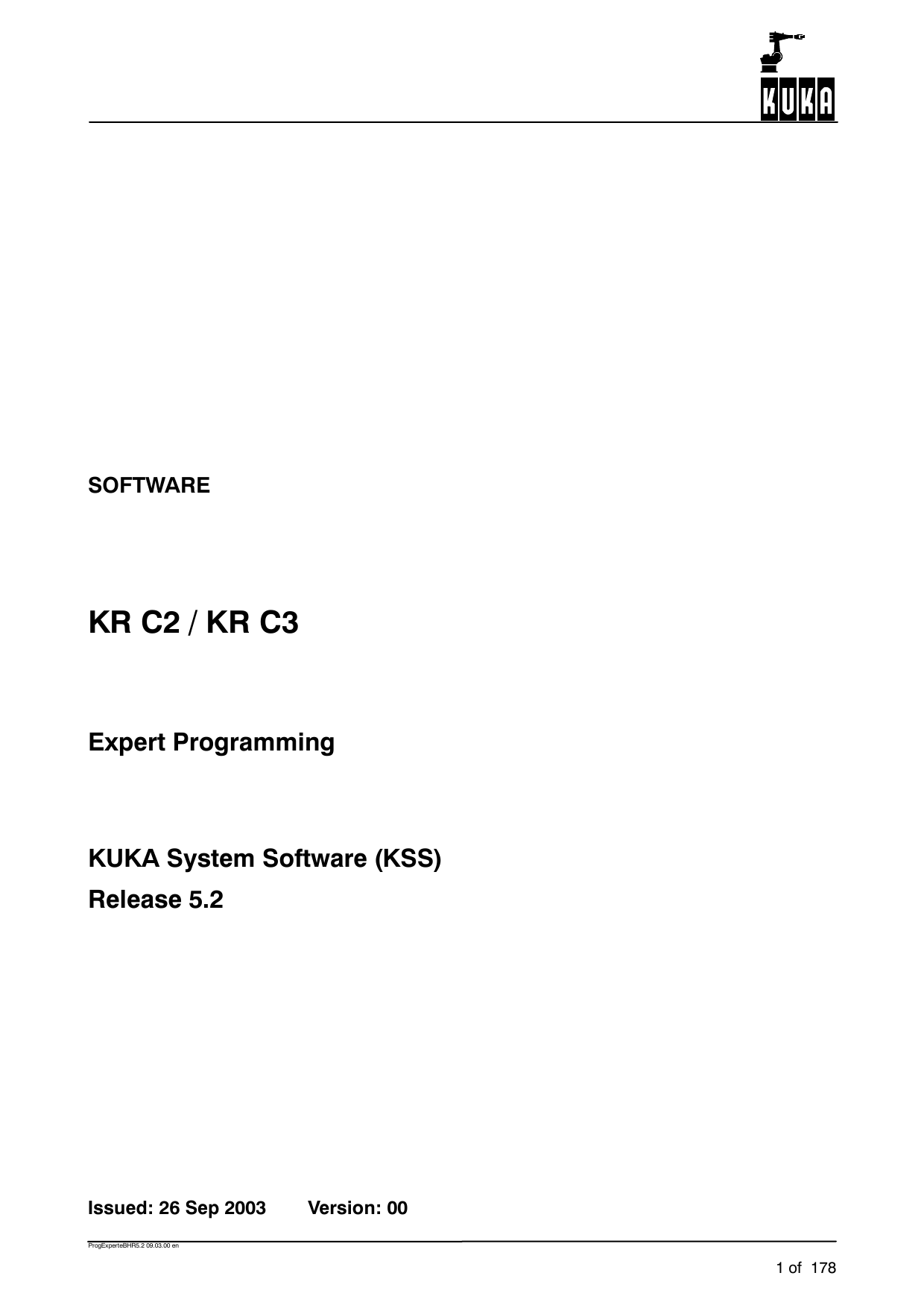RoboDK supports all KUKA robot controllers since KRC2, including KUKA KRC3 and KRC4 controllers. This documentation is based on a KRC4 controller. The KRC4 robot controller runs the Microsoft Embedded Windows 7 operating system. Previous controllers, such as KRC2, run Windows 95. The robot teach pendant shows an “HMI” which is a program that KUKA developed to run on Windows and it is the interface that the robot user must use manipulate the robot.
However, the control scheme has been implemented and tested on a KUKA LWR 4+ which allow manual guidance thanks to the embedded impedance controller and has a backdrivable structure. In this paper we exploit the results obtained in 8, 9 to implement a control architecture that allows human-robot cooperation during the programming phase of a. KUKA Roboter GmbH College Petter 26.05.15 Seite 15 LBR iiwacourses LBR iiwa–Advanced SensitivityProgrammingfor Industrial Applications 4 days Commissioning and Programming LBR iiwa 10 days FBT ProfiNet forKSS 8.x u. KUKA.SunriseOS 2 days Programming KUKA Sunrise.Connectivity 1 day LBR iiwa-Safety-Start-Up and HRC-Programming 4 days. 11: The KUKA Robot Programming Language TOPIC 1: Movement The KUKA robot can move from point A to point B in three main ways. PTP – Point-to-Point – Motion along the quickest path to an end point. This motion requires the programmer to “teach” one point. LIN - Linear – Motion at a defined velocity and acceleration along a. I need kuka krc1 programming manual hello i need kuka krc1 programming manual thank you. Advanced Search. You can Sign Up for free!

The following sections demonstrate typical operations using a KUKA robot teach pendant to prepare a new program in RoboDK and transfer it to the robot.
Transfer a robot program
Follow these steps to load a program form a USB disk to your KUKA KRC4 robot controller.
1.Insert the USB disk on the robot controller (it is much faster than using the teach pendant connection)
2.If we don’t see the USB disk we must enter in Administrator mode
3.Select the file from the USB disk
4.Select Edit➔Copy
5.Select a folder in the KRC unit
6.Select Edit➔Paste
Start a robot program
Follow these steps to start a robot program on your KUKA KRC4 controller.
1.Select a program from the KRC memory unit
2.Select Select on the screen
3.Select the button “R” (top) and Reset program
4.Start the program by selecting green “Play” button on the teach pendant
Retrieving the TCP
The following steps allow you to create or modify robot tools (TCP) from your robot controller, also known as $TOOL in KUKA KRC robot programming):
1.Select MENU➔Start-up➔Calibrate➔Tool
2.Select a tool and edit or retrieve the X,Y,Z position of the TCP.
Retrieving the robot joints
The following steps allow you to retrieve the robot joints from your robot:
1.Select MENU➔Display➔Actual position
2.Select Joints mode and use the left column to take the robot joints
Administrator mode
Some menu sections require “Administrator” rights. The following steps allow entering in “Administrator” mode:
1.Select MENU➔Configuration➔User group
2.Select Administrator (or other).
3.Enter the password if required (default password is “kuka”)
Kuka Advanced Programming Manual Software
RoboDK driver for KUKA
Robot drivers provide an alternative to Offline Programming (where a program is generated, then, transferred to the robot and executed). With robot drivers, it is possible to run a simulation directly on the robot (Online Programming). More information available in the Robot Drivers section.
A connection between RoboDK and the KUKA robot can be established to move the robot automatically from a connected PC using RoboDK. This allows using the RoboDK Run on robot option for online programming and debugging. The connection can be established through a standard Ethernet connection (TCP/IP).
Follow these steps to set up the RoboDK driver for KUKA:
1.Connect a mouse (optional, but strongly recommended).
It is possible to plug USB devices to the teach pendant or the controller (reboot is not required).
Alternatively, it is possible to establish a remote desktop connection.
These steps can also be accomplished using the teach pendant’s touch screen and the virtual keyboard.
2.Using the KUKA HMI application it is possible to open the main menu using the KUKA button , at the top left of the screen:
a.KUKA➔Configuration➔User group➔ choose Administrator (password: kuka)

b.KUKA➔Start-up➔Service➔Minimize HMI (the windows screen will appear)
Kuka Krc4 Manual
3.Copy the KUKAVARPROXY folder on the Desktop (or somewhere in the controller PC)
4.Allow port 7000 for TCP/UDP communication (this step is not required on KUKA KRC2 controllers):
a.Select the HMI.
b.KUKA➔Start-up➔Network configuration➔Advanced
c.NAT➔Add port➔Port number 7000
d.Set permitted protocols: tcp/udp
5.Start the KUKAVARPROXY.EXE program on the robot controller (running on Windows).
6.These steps allow starting the driver automatically on the controller on reboot (recommended):
a.Create a shortcut of the KUKAVARPROXY.EXE file
b.Select Windows START➔All programs➔Right click startup➔Open
c.Paste the shortcut in the startup folder
The KUKAVARPROXY server is now ready. You can leave this program running. This server allows exchanging global variables from the KUKA controller to the remote PC.
The next steps are to set up the main program that will handle the robot movements:
1.Add the declaration of the following global variables:
To do so, locate and modify the file “KRCR1STEU$config.dat” (or in “KRCR1System$config.dat” for KRC2 controllers). The folder “KRCR1” can also be accessed from the C: drive at the following Windows path: “C:KRCROBOTERKRC”.

INT COM_ACTION=0
INT COM_ACTCNT=0
REAL COM_ROUNDM=0
REAL COM_VALUE1=0
Kuka Krc2 Controller Manual
REAL COM_VALUE2=0
REAL COM_VALUE3=0
REAL COM_VALUE4=0
DECL E6AXIS COM_E6AXIS
DECL FRAME COM_FRAME
DECL POS COM_POS
2.Copy the SRC program provided (RoboDKsynch.src) to the folder KRCR1.
3.Manually start the RoboDKsynch.src program to make the robot behave like a server that responds to move commands coming from the PC.
If the RoboDKsynch.src program is not running, RoboDK will still be able to read the robot joints anytime if the KUKAVARPROXY program is running in the robot controller.